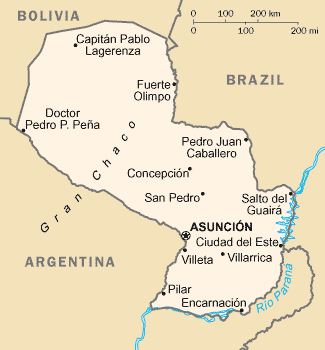Paraguay

Geography
-
Paraguay is divided by the Rio Paraguay into the eastern region —officially called Eastern Paraguay (Paraguay Oriental) and known as the Paraneña region — and the western region — officially Western Paraguay (Paraguay Occidental) and also known as the Chaco.
The southeastern border is formed by the Paraná River, containing the Itaipu dam shared with Brazil. It is currently the largest hydroelectric power plant in the world, generating nearly all the electricity required by Paraguay. Another large hydroelectric power plant on the Paraná River is Yacyretá, shared by Paraguay and Argentina. Paraguay is currently the world's largest exporter of hydroelectric power.
The terrain is made up of grassy plains and wooded hills to the east. To the west, there are mostly low, marshy plains.
The local climate ranges from subtropical to temperate, with substantial rainfall in the eastern portions, though becoming semi-arid in the far west.
Economy
-
Paraguay has a market economy marked by a large informal sector that features both re-export of imported consumer goods to neighboring countries, and thousands of small business enterprises. Paraguay's largest economic activity is based on agriculture, agribusiness and cattle ranching. Paraguay is ranked as the world's third largest exporter of soybeans, and its beef exports are substantial for a country of its size. A large percentage of the population derive their living from agricultural activity, often on a subsistence basis. Despite difficulties arising from political instability, corruption and slow structural reforms, Paraguay has been a member of the free trade bloc Mercosur, participating since 1991 as one of the founding members.
Paraguay's economic potential has been historically constrained by its landlocked geography, but it does enjoy access to the Atlantic Ocean via the Paraná River. Because it is landlocked, Paraguay's economy is very dependent on Brazil and Argentina, its neighbors and major trade partners. Roughly 38 percent of the GDP derives from trade and exports to Brazil and Argentina.[6]
Through various treaties, Paraguay has been granted free ports in Argentina, Uruguay and Brazil through which it sends its exports. The most important of these free ports is on the Brazilian Atlantic coast at Paranaguá. The Friendship Bridge that now spans the Paraná River between Ciudad del Este and the Brazilian city of Foz do Iguaçu permits about forty thousand travelers to commute daily between both cities, and allows Paraguay land access to Paranaguá. A vibrant economy has developed in Ciudad del Este and Foz do Iguaçu mostly based on international commerce and shopping trips by Brazilian buyers colloquially called sacoleiros.[7]
Bilateral EU-Paraguay trade in goods amounts to €437 million in 2005; the EU importing around €269 million and exporting roughly €168 million. In 2005, trade with EU represented 8.9% of total Paraguay’s trade. The EU market represents 13.7% of Paraguay exports and 6.1% of its imports.[8]
While the country’s external debt remains satisfactory (40% of GDP), Paraguay’s economy is still driven by agricultural production (27% of GDP and 84% of exports). It is a structure which is very vulnerable to climatic factors and price volatility. In 2004 its main exports were soybeans (35%) and meat (10%). Because of the regional crisis, very limited economic growth (2.7% in 2005) and a population increase, GDP per capita has fallen considerably in the long term, standing at USD 1 155 in 2005. Combined with inequality, the aforementioned factors explain why poverty currently affects 40% of the population.[9]
Although only ranked 112th out of 175 countries in the 2006 World Bank Doing Business ranking, Paraguay has ranked particularly well in the "Protecting Investors" sub-category within that index. The indexes vary between 0 and 10, with higher values indicating greater disclosure, greater liability of directors, greater powers of shareholders to challenge the transaction, and better investor protection, respectively.
The "Disclosure Index" for Paraguay is 6, whereas the Latin American region ranked only 4.3 (OECD countries ranked 6.3 on average). The country ranked 5 in "Director Liability Index", the same as OECD countries and better than the 5.1 attributed to its neighbors. In the "Shareholder Suits Index" category, Paraguay obtained 6 points, in contrast with 5.8 for its neighbors and 6.6 for OECD countries. The comprehensive "Investor Protection Index" attributed 5.7 to Paraguay, 5.1 to its neighbors and 6.0 to OECD countries on average.[10]
see more: http://en.wikipedia.org/wiki/Paraguay
Comments (0)
You don't have permission to comment on this page.